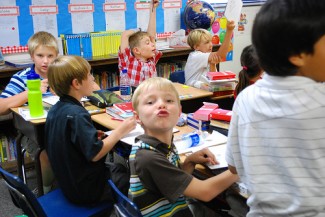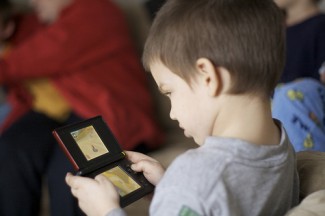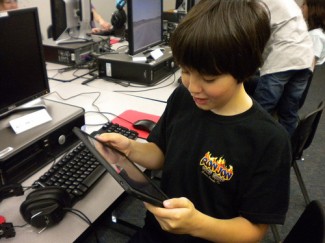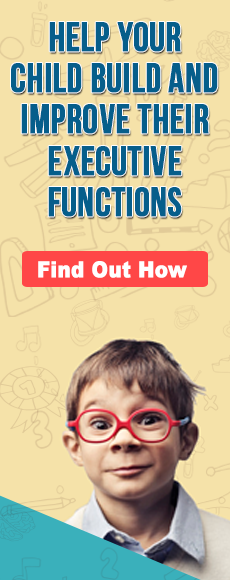 Overview
Overview
With this thinking skill, students learn to control their feelings—both negative and positive—so as to maintain the ability to make good decisions and stop themselves from engaging in impulsive behavior. For example, when a student is answering a question on a quiz, she needs to use Self-Control in order to refrain from writing the first thing that comes to mind and, instead, take the time to think about the question thoroughly in order to determine the best possible answer. Self-Control is a thinking skill that is composed of two separate, but closely related executive functions: Regulation of Affect and Response Inhibition.
Self-Control can be an important part of success in the classroom. Students have to use Self-Control to remain appropriately engaged in classroom activities. In a science lab, they have to use Self-Control in order to maintain their own safety as well as the safety of their peers. They also have to use Self-Control when working with a group to stay on task. They also need to use Self-Control to use classroom materials appropriately.
Click here for more Self-Control Fundamentals.
Self-Control Skills in the Classroom
 Using effective Self-Control skills can help students succeed in a variety of classroom contexts. The following list outlines some common classroom situations that require the use of Self-Control skills:
Using effective Self-Control skills can help students succeed in a variety of classroom contexts. The following list outlines some common classroom situations that require the use of Self-Control skills:
- Dealing with frustration: Many frustrating situations can arise at school, such as working on a difficult assignment, getting into a disagreement while working in a group, losing a game, waiting in line at lunch, etc. Students need to exhibit self-control in order to respond appropriately (thinking before acting) and move forward, rather than acting on impulse.
- Accepting consequences for behavior: When a student is redirected by the teacher or given a consequence for inappropriate behavior, he needs to use self-control in order to accept this feedback. If he acts on impulse and is disrespectful, the situation is likely to escalate.
- Taking turns when speaking: When having conversations with peers, or participating in a whole class discussion, students need to use self-control to wait until the appropriate time to speak. Even though a student might have something she really wants to add to the discussion, there are times when it is not appropriate to just blurt out her ideas.
- Reading the directions before starting an assignment: Many times if students feel they generally understand an assignment, they will start it without taking the time to go over the directions thoroughly. They need to use self-control and make sure they have a clear understanding of expectations before beginning a classroom task so as not to have to restart it later.
Teaching Self-Control Skills with Digital Media
 Working with digital media requires children to use self-control skills regularly. When students are confronted with new technology, they need to be patient during the learning process. For example, if a student is using blogging software in the classroom for the first time, she needs to be patient while she learns the ins and outs of the program. She will likely make mistakes as she tries to make her first classroom post. She will need to learn from those mistakes, rather than let frustration take over.
Working with digital media requires children to use self-control skills regularly. When students are confronted with new technology, they need to be patient during the learning process. For example, if a student is using blogging software in the classroom for the first time, she needs to be patient while she learns the ins and outs of the program. She will likely make mistakes as she tries to make her first classroom post. She will need to learn from those mistakes, rather than let frustration take over.
Self-Control is also an important part of successful video game play. Players practice self-regulation when they deail with the frustration of having to repeatedly restart levels. It takes self-control skills to cope with the trial-and-error nature necessary for learning new skills within a game. Many games require that players use their experiences of failure to guide their ongoing decision making. The capacity to handle disappointment and, more importantly, to maintain emotional stability that facilitates clear thinking is a key to success. Games such as Tetris and Bejeweled require players to start over again frequently, particularly as they get to higher levels of the game.
Video games also offer numerous opportunities for response inhibition. Sometimes players to have to restart a game or lose any progress that they have made on a particular game level. Players need to recognize when their immediate reactions no longer serve them in the game. They may successfully use an action on one level, only to find that it no longer works in the next level. For example, playing a simple computer game such as Tetris might involve quick decision making, yet at the same time, thinking before acting. Other, more complicated games may require that players stop their current actions to avoid “injury” or “losing lives.” (It is important to note that many video games are best learned by experimenting and making mistakes, rather than by reading directions.) Learn more about how game play can help improve Self-Control skills.
Check out our classroom guides for information on how to use specific games and digital technologies to teach Self-Control skills.
Alternative Learning Concerns & Self-Control
 Many Alternative Learners struggle to use Self-Control skills in the classroom. Often these students need guidance about how to use strategies to deal with distractions and frustrations in ways that don’t become disruptive. Our Classroom Guides provide teachers with ideas on how to integrate digital media into instruction to teach students how to use Self-Control skills effectively.
Many Alternative Learners struggle to use Self-Control skills in the classroom. Often these students need guidance about how to use strategies to deal with distractions and frustrations in ways that don’t become disruptive. Our Classroom Guides provide teachers with ideas on how to integrate digital media into instruction to teach students how to use Self-Control skills effectively.
ADHD & Self-Control
Students who are diagnosed with Attention Deficit Hyperactivity Disorder (ADHD) and other attentional problems can often struggle to use Self-Control in the classroom, especially when they become distracted, overwhelmed, or frustrated. Students with attention difficulties sometimes act impulsively without thinking about consequences. Teachers need to provide these students with strategies to stop and think about their behavior before acting so that they can make more appropriate choices.
Video games and other digital technologies often require users to practice Self-Control, making them great tools for teachers of students with ADHD. In many video games, for example, students have to control their impulses in order to succeed at various tasks. Students also have to learn how to tolerate frusrtations as they learn by trial and error.
ASD & Self-Control
Students who are diagnosed with Autistic Spectrum Disorders often struggle to regulate their emotions when they encounter a situation that makes them feel overwhelmed, such as a change in the schedule, working with a new group of peers, or dealing with a disappointment. When students with ASD experience these escalating emotions, they often have trouble calming themselves down and can sometimes lash out at others and/or engage in disruptive class behavior.
Many video games and other technologies are available that help build Self-Control skills. Students with ASD can benefit from practice in tolerating frustration, which is present in many trial and error learning games. There are also technologies available that are designed to help teach students different strategies for dealing with frusrtations appropriately, and can be great tools for teachers of students with ASD.
Anxiety/Depression & Self-Control
Self-Control can also be difficult for students diagnosed with anxiety and/or depression. Many of these students have trouble regulating their emotions and can get stuck in a negative frame of mind. They might have trouble engaging in classroom activities and lack necessary coping skills to deal with their negative emotions, and thus can end up acting inappropriately and making bad choices.
Using video games and other digital technologies in the classroom can be helpful for students with anxiety and or/depression because they allow students to have positive interactions with others and engage in playful activities in the classroom. They can help release some of the tension often felt by these students that can lead them to lash out or make bad choices when they are unable to step back and think clearly about consequences of their behavior.
Behavioral Problems & Self-Control
Students with behavioral problems often struggle to use Self-Control skills. When these students become frusrated or upset, they frequently have trouble coping with these emotions, which causes them to escalate. Many students with behavior problems have difficulty thinking ahead about their behaviors when they are in an escalated emotional state, and can end up acting impulsively and disrupting the classroom environment. Many times they don’t think about how others around them will be affected by their behavior.
Using digital media in the classroom can be a great way for teachers to help students learn self-control skills. There are many technologies available that help students practice self-control in order to be successful. For example, many video games and apps that involve using strategies to solve a puzzle or move ahead require that students think before acting, and take the time to measure the consequences of each move they make.
LD & Self-Control
Using Self-Control skills can be difficult for some students with Learning Disabilities as well. These difficulties will vary based on the students’ individual learning profiles. Some students may impulsively answer questions on a quiz without reading the entire question or taking adequate time to think about the right answer. Some students may become frustrated when an assignments seems to difficult and make negative choices when trying to deal with their frustration. Others may have trouble with step-by-step directions and impulsively move through the steps without taking the time to slow down and think about each one.
Incorporating digital media in the classroom provides many opportunities for differentiation in order to meet the needs of all students, and to help build Self-Control skills. Our Classroom Guides are great tools to use for teachers of students with Learning Disabilities because they are adaptable, meaning teachers can decide how best to use them based on the individual needs of the students.
Educators Guide to the Executive-Functioning Skill of Self-Control
Self-Control is a skill that is composed of two separate but closely related executive functions: regulation of affect and response inhibition. With this thinking skill, children learn to control their feelings – both negative and positive – so as to maintain the ability to make good decisions and stop themselves from engaging in impulsive behavior. For example, children who get frustrated when they get the same math problem wrong over and over on a test display good Self-Control if they can take a deep breath and think through what they are missing rather than just writing down the first thing that comes to mind.
The two component executive functions of Self-control are defined as:
Regulation of affect: Regulation of affect involves the ability to manage one’s feelings effectively in order to make decisions, control behavior, and complete a task. It includes the ability to sustain one’s effort in the face of frustrations and difficulties. Individuals who can effectively regulate their feelings display the capacity of self-control. They are able to label and describe their feelings and can generally recognize what is behind or the cause of what one feels.
Effective regulation of affect involves an ability to recognize the connection between one’s thoughts, feelings, and actions. There is a clear developmental component to effective regulation of affect: temper tantrums that are appropriate at age 2 are no longer seen as acceptable behavior as a child moves into elementary school. Individuals who are able to display effective self-control often give themselves messages through self-instructional strategies, by being positive or optimistic, or by learning how to take a “time out” when their feelings may be getting the best of them.
Response inhibition: Response inhibition involves the ability to stop or delay an action and to reflect rather than display impulsive behavior. Response inhibition is a very important skill for safety and displaying socially appropriate behavior and efficient problem solving.
Self-control allows children to stop ineffective and inappropriate (destructive/irresponsible) actions so that they can plan, consider, and display appropriate behavior. Self-control is important children’s ability to size up and monitor a situation before acting. This skill is important in noticing the nonverbal and social cues that help guide behavior. Self-control is important in understanding acceptable behavior in a particular situation and is a necessary component in considering the possible consequences of one’s behavior.
How can I tell if a student is having trouble with Self-Control?
These descriptions might help you identify a student struggling with Self-Control in the classroom. In general, look for difficulty in handling moderate classroom demands. Students who are easily frustrated, get angry with their peers, or get in trouble in unstructured situations are likely to display problems with self-control. As with all of the Thinking Skills in the Playing Smarter curriculum, struggles with Self-Control are likely to co-occur in most students with other areas of weakness in thinking skills.
All Students:
- Having difficulty taking turns in group projects
- Blurting out answers to questions without raising hand
- Not reading directions before starting assignments or taking a test
- Having difficulty sitting still during teacher presentation of material
- Rushing through homework and often missing items
Particularly Important for Elementary Students:
- Becoming overly excited and having difficulty calming down in class, on the playground, or during group activities
- Displaying difficulty waiting one’s turn
- Having difficulty waiting for permission or directions before doing something
- Displaying difficulty controlling physical impulses such as grabbing, pushing, and shoving
Particularly Important for Middle School Students:
- Starting work before listening to directions
- Continuing to talk when the rest of the class has stopped
- Talking too loudly in the classroom
- Making simple errors in math such as mistaking a plus sign for a minus sign
When do students use Self-Control skills at school?
These are common school-based situations where the thinking skill of Self-Control is needed. The best way for students to learn the skill of Self-Control is to practice it while engaged in daily activities. Take the time to recognize these common situations and when you can encourage your students to employ and improve their Self-Control skills.
- When completing a lengthy or frustrating assignment or test
- When working with classmates on a group project
- When working on a puzzle or riddle
- When waiting in line for library or gym
- When reacting appropriately to teacher discipline
- When accepting an athletic team loss or perceived unfair situation
- When raising one’s hand before answering a question in class
- When waiting for one’s turn to speak during a conversation
- When reading the directions before starting an assignment
- When completing a long, multi-step task
How can I help my students practice their Self-Control skills in the classroom?
- Use self-talk such as “take it easy” or “slow down” prior to responding to a situation. Realistically describe that you may still feel angry but now have more control over your reaction. Catch the students at an angry moment and coach them in “stopping” techniques and self-talk. Notice and praise the students when they use these strategies independently.
- Increase the students’ frustration tolerance by incrementally creating more frustrating games and activities. Have the students play a game that frustrates them in order to practice coping strategies to help them work through their emotions. For example, count how many lay-ups out of 10 they can make while playing basketball, then move back 2 feet at a time to increase the difficulty of the task. Help the students to understand that “you can’t win them all.” Assist them in being realistic and understanding that they will not get the ball into the basket every time.
- Have the students develop stories or narratives that explain their behavior. Encouraging the students to talk about their feelings (for example, “I’m angry because my friends always tease me when I lose”) could help them better regulate their expression of feelings. Provide an example from your own experience (such as your having been upset when your boss gave you a large project to do on your way out the door from work) and describe how you handled your frustration. Role-play hypothetical scenarios and discuss various reactions.
- Provide the students with verbal praise and rewards for not being impulsive and when an inappropriate response is stopped or paused. Choose one or two specific impulsive behaviors to address such as blurting out answers or not taking turns. Provide the students with strategies to avert the impulsive behavior such as covering one’s mouth with the left hand while raising the right. This could be applied in a school or home setting where a teacher or parent could give age-appropriate awards.
- Have the students think about their answer to a question a few seconds before they verbalizes their response. Teach the students to count to 10 before acting. Practice this by counting together out loud before making a decision.
What tips can I give my students to help them improve their Self-Control skills?
- Talk to yourself quietly. Use instructions such as, “calm down” or “take it easy.”
- Physically hold yourself back. In class this might mean sitting on your hands when you are afraid you are going to get out of your seat.
- Keep your hands in your pockets in line so you don’t push anybody. Put your hand over your mouth so you don’t speak out when you’re not supposed to.
- Take a short break when you’re feeling frustrated. It’s OK to give yourself a time-out to gain control of your feelings.
- Take three very slow, deep breaths and then address the problem.
- Focus on thoughts that are fun or happy. Have one or two pictures in your mind that you can easily see in your mind’s eye. This might include thoughts of having fun at the beach, exploring in the woods, or spending time with your family pet.
- Talk to someone when you’re feeling very upset – a friend, a parent, or someone else you can trust.
Classroom Guides for Self-Control
[post_grid id=”95984″]




